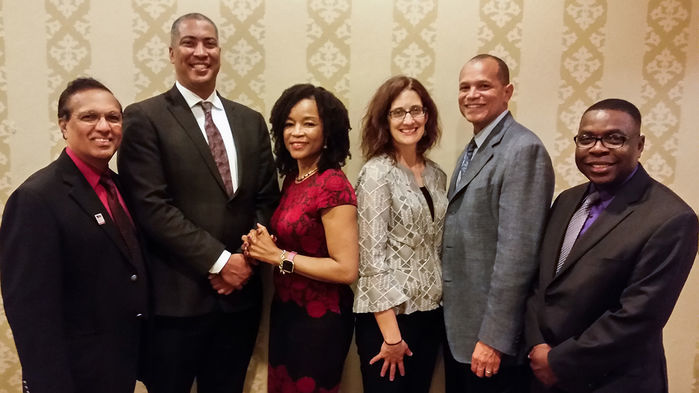By Jeffrey Mervis
Science, December 19,2017 —

Three years ago, the National Institutes of Health (NIH) in Bethesda, Maryland, funded a novel project that offers online mentoring of students, mentorship training for senior faculty, and grantsmanship skills for early-career scientists. The National Research Mentoring Network (NRMN) was part of a much bigger NIH initiative to increase the diversity of the biomedical research workforce.
But this month, NIH announced it would be taking a different approach in the second phase of NRMN, putting more emphasis on understanding the factors affecting the status of minorities. This decision could mean the demise of the current version of NRMN, which was designed to provide direct services to those in the field.
It could also delay progress toward one of the primary goals of the larger initiative: Reducing the racial disparity among similarly qualified applicants for NIH grants.
“Initially, it wasn’t clear if the focus of NRMN was to be on research, service, or both,” says Alison Gammie, director of training, workforce development, and diversity at NIH’s National Institute of General Medical Sciences in Bethesda, Maryland. “So we want to make it very clear that we want a strong research component.”

NRMN is part of NIH’s Diversity Program Consortium, a 5-year, $250 million initiative launched in response to a 2011 report showing that black applicants fare significantly worse than whites in competing for NIH research grants. The bulk of the consortium’s investment goes to Building Infrastructure Leading to Diversity (BUILD), 10 projects scattered around the country that are testing different ways to overcome barriers facing undergraduate minority students who want to pursue careers in biomedical research. A third piece, the Coordination & Evaluation Center (CEC) based at the University of California, Los Angeles, is evaluating the effectiveness of NRMN and the BUILD projects.
NRMN got off to a slow start after NIH ordered a last-minute addition to its team of investigators and assigned the project additional duties. Its founding lead scientist stepped down out of frustration and was not replaced for several months, causing further delays. The team leading the online matching of mentors and mentees has also struggled with the protocol governing those interactions—how long the initial relationship should run, for example, and the topics to be covered—and clashed with NIH officials over the best way to boost participation.
New funding for research
On 7 December, NIH unveiled its plans for the second phase of the diversity initiative in the form of six notices heralding a future funding solicitation. NRMN would undergo a major transformation, with its activities basically put up for grabs by the entire community. In contrast, the BUILD and CEC programs would essentially maintain the status quo, assuming that their plans for the next 5 years pass muster with NIH reviewers.
“Each of the BUILD sites had pretty complicated experiments to set up, and the data are just being collected,” Gammie explains. “As in a clinical trial, you wouldn’t want to enroll new people in the middle of the trial. So we want to maintain the [BUILD awards] as renewals. Likewise for the CEC, we wanted an uninterrupted flow of data.”
Specifically, NIH wants to fund research in three areas at the core of NRMN. It has relabeled them “the science of mentorship, professional networking, and navigating career transition points.”
It will also hold a competition to operate the current online mentee-mentoring network, which it has relabeled a resource center. The day-to-day operations of NRMN, now handled by a small staff at Boston College, will also be thrown open to other bidders.
“I won’t want to disparage anything that has been done,” Gammie says. “But we wanted to open it up to get an infusion of new ideas and to get some really solid research done in this area.”

The principal investigators for the National Research Mentoring Network are pondering its future. The principal investigators (PIs) from left: J. K. Vishwanatha, Rafael Luna, Elizabeth Ofili, Christine Pfund, Keith Norris (PI for the Coordination and Evaluation Center), and Kola Okuyemi. (Jeffrey Mervis)
The scientists now leading the various components of NRMN are still trying to digest news of its possible deconstruction, and their response to the pending solicitations. “We have not even had a chance to talk as a group yet,” Christine Pfund, a cell biologist at the University of Wisconsin inMadison who leads NRMN’s mentor training core, wrote in an email. “Lots to discuss after the holidays.”
Pfund and her colleagues run workshops aimed at improving the mentoring skills of senior scientists, with an emphasis on the challenges facing black people, Hispanics, Native Americans, Pacific Islanders, and those with disabilities. Some of those faculty members then lead similar sessions on their own campuses, increasing the number of people trained in culturally aware mentoring.
Gammie says that approach is laudable but that NIH wants to take a more experimental approach. “I think what they are doing is great,” she says. “But before they are convinced of its value, people will want to see data from comparison groups, in different institutional contexts, and using different approaches to mentor training.”
A new direction for networking and grant training
The future of NRMN’s networking component is also unclear. Jamboor Vishwanatha, a molecular geneticist who directs a center for health disparities at the University of North Texas Health Science Center in Fort Worth, now oversees the pairing of mentors and mentees and their interactions. But that task will fall to whoever wins the new competition to manage the “resource center,” Gammie says.
She adds that NIH is also interested in supporting research on what effective networking looks like. “We don’t have a lot of data on what is needed, whether it’s long-term or a few key short-term interactions,” she says. “If we see that people with more connections tend to be more successful, then that is something you might want to work on as a trainee.”
Gammie also cites preliminary findings suggesting that “differences in people’s networks can really shape people’s career outcomes,” adding that the impact varies by race and gender. “So I think there’s a lot more work we need to do in this space.” She draws a distinction between the two types of NRMN activities, calling one “research” and the second “the logistics needed for people to network.”
In launching the diversity consortium, NIH Director Francis Collins talked about how decades of NIH programs have done little to correct the racial disparities in success rates highlighted in the 2011 study, which was led by economist Donna Ginther of the University of Kansas in Lawrence. NRMN’s professional development core, led by Kola Okuyemi, chair of family medicine at the University of Utah’s medical school in Salt Lake City, is aimed at closing the gap by honing the grantsmaking skills of minority applicants.
The new research competition on career transitions is meant to address that problem, Gammie says. “The hope is that we’ll move into a research focus, learning what types of interventions are effective in helping people get awards,” Gammie says. She acknowledges that conducting more research on the problem could lengthen the time needed to close the gap. But she expects that approach to pay off in the end.
“You have to do the research, in hopes of having a broader impact, rather than providing a service for a finite number of people,” she notes. “And that data could be very helpful in convincing institutions around the country of the need to implement those practices.”
NRMN has a fourth core that focuses on outreach to minority-serving institutions participating in another NIH program aimed at helping boost their capacity to carry out mentoring. That effort is led by Elizabeth Ofili, a cardiologist at Morehouse School of Medicine in Atlanta. Gammie speculated that those activities would fall under the purview of the winner of the competition for the coordinating center.
A chance for early adopters
The December announcement also creates a new type of award for institutions outside of NRMN that want to set up programs to boost minority participation based on findings from NRMN and BUILD researchers. These Dissemination and Translation (DaTA) awards will be open to institutions that receive relatively little NIH grants money and enroll a large percentage of low-income students.
Unlike the other funding opportunities, which have a proposal deadline of next June, DaTA award applications won’t be due until January 2020. The delay is intended to give the BUILD and NRMN projects more time to analyze their results and create a mechanism by which other institutions could readily adopt them.
NIH plans to offer potential applicants more details before the formal competition kicks off in April. And although the winners of all but the DaTA awards won’t be announced until July 2019, Gammie says it’s already clear what the second phase of the diversity consortium will look like. “At that point there will be a coordination center and a resource center and some exciting research projects going on,” she says.
What’s not clear, however, is the extent to which the existing NRMN investigators—and the program’s current practices—will be part of that vision.










